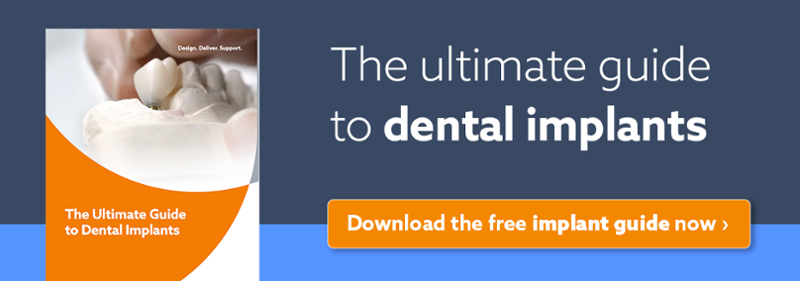There are approximately 35 million edentulous people in the United States. Even though dental implants have been available for decades, many patients are still unaware of how this treatment could benefit them. Concerns about costs and the nature of the surgical procedures required will often deter people from enquiring about implants. To the surprise of many people, implant retained dentures frequently offer an affordable and conservative treatment option. A denture can be successfully retained with as few as two conventional dental implants. Another possible treatment choice is to use four conventional implants or four to six small diameter implants.

Using Two Dental Implants to Retain a Denture
With this treatment, two conventional implants with a diameter of 3mm or greater can be placed in the canine areas. Implants with a diameter of 4mm and length of 12mm are a popular choice for this treatment. Greater stability will be obtained if an additional two dental implants can be located in the posterior regions, depending on the patient’s finances and available bone. This can be a desirable choice for a patient who has a denture that is in reasonable condition which can be retrofitted after the implants are placed. Alternatively, if the denture needs replacing then a new prosthesis can be made after the implants are placed. Once the implants have been placed, it is necessary to decide whether to immediately load them. If there is any question about the quality of the bone, it can be better to wait until healing is completed. Adapting an existing denture with soft reline material will provide the patient with a usable set of teeth.
Using Small Diameter Implants to Retain a Denture
Small diameter implants (SDIs) have been FDA approved for the past 20 years and are made from titanium alloy. They are suitable for patients who lack sufficient bone to place conventional diameter implants. Often bone will be inadequate in the canine area, making it impossible to place conventional diameter implants. SDIs can be placed in as little as 3-4 mm of bone, compared to conventional implants that need at least 6 mm of bone facially to lingually. SDIs can be evenly spaced between the canines to provide adequate support. Just four SDIs may be needed to support a lower denture. When used in the maxilla, it is common to use six SDIs because the maxillary bone is not as dense as mandibular bone. If the implants are stable when inserted into the bone, they can often be immediately loaded. An existing denture that is in good condition can be rebased or a new denture can be made.
Using Four Conventional Implants to Retain a Denture
Usually, there is a greater amount of bone in the anterior region of the mandible or maxilla than in the posterior regions, and locating implants in these areas maximizes the use of available bone. However, sometimes there will be sufficient high-quality bone in the posterior region allowing the placement of two implants in the anterior area and two implants posterior to the mental foramen. One possible disadvantage of this technique is that costs tend to be higher, making this a less affordable option for patients.
Affordability and ease of maintenance are two of the biggest advantages of implant retained dentures. Patients can enjoy good esthetics while a removable prosthesis is easy to keep clean. Any repairs or maintenance can usually be carried out relatively inexpensively. The initial cost of treatment is considerably lower than for fixed implant-supported restorations.
We are here to help. Should you have any questions or want to discuss a specific case, please schedule a call with one of our expert technicians.
Click here to schedule an expert consultation »
